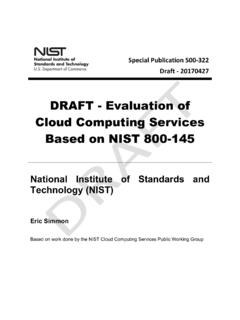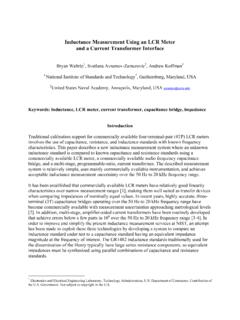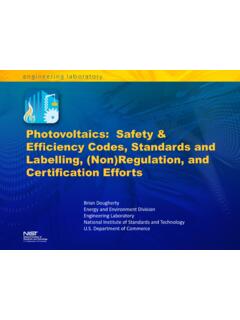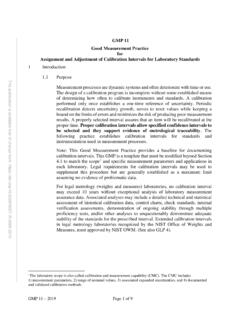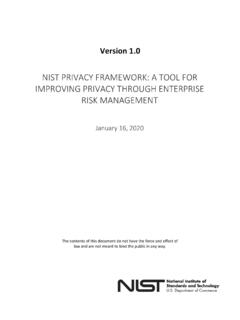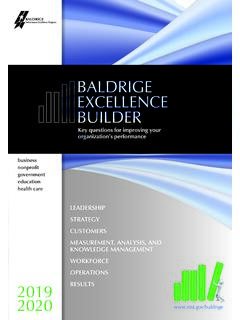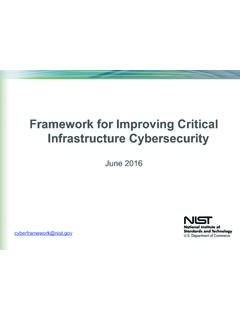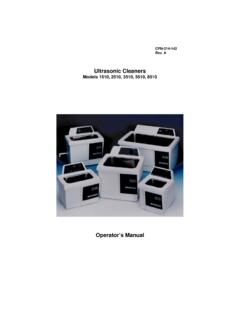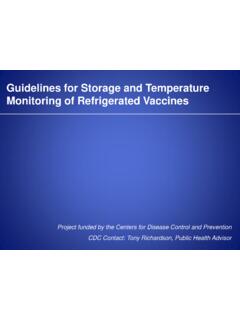Transcription of Financial Services Sector Specific Cybersecurity “Profile”
1 Financial Services Sector Specific Cybersecurity Profile NIST Cybersecurity WorkshopMay 17, 2017 1\2A Complex Regulatory and Cybersecurity Environment for Financial ServicesFinancial Services Sector Specific Cybersecurity Profile The Way Forward: Collaboration and Next StepsOur Sector s Shared Goal\Our Sector s Shared Goal with the Financial Services Regulatory Community: Advancing the safety, soundness, and resilience of the Financial system by mitigating and protecting Financial institutions and the Financial Sector from increasing Cybersecurity Action to Meet Our Shared Goal:1)Established the Financial Services Information Sharing and Analysis Center (FS-ISAC)in 1999. Today, the FS-ISAC has ~7,000 members in 38 )Fostered Sector -wide Cybersecurity collaboration through eight Joint Financial Associations Cybersecurity Summits. 3)Created Sheltered Harborto enhance resiliency and provide augmented protections for Financial institutions customer accounts and )Developed and convened 13 Hamilton Series cyber exercisesin 2014-16 in collaboration with the various Government )Developed a DRAFT Financial Services Sector Specific Cybersecurity Profile in response to a complex regulatory and Cybersecurity \4A Complex Regulatory and Cybersecurity Environment for Financial ServicesFinancial Services Sector Specific Cybersecurity Profile The Way Forward.
2 Collaboration and Next StepsOur Sector s Shared Goal\5 The Financial Services Regulatory Structure (2017)\Many Financial Services Cyber-Related Proposals Describe Similar Concepts to the NIST Cybersecurity Framework (but with Different Terminology)6\Why Language MattersNIST s Identify function regarding Risk Management Strategy mapped to 9 different regulatory Requirement column, shows how each proposal modifies language and definitions, requiring firms to comply with largely the same but distinct \8 NIST Cybersecurity Framework (CSF) is - De facto standard for firms seeking guidance to counter cyber Meets the requirementsto be flexible, repeatable, performance-based, and cost-effective. Adaptable to organization's maturity through implementation to an industry survey 91%of companies surveyed either use NIST CSF or ISO/IEC27001 entities and Sector - Specific agencies (SSA) have promoted and supported the adoption of the NIST CSF in the critical infrastructure sectors.
3 Department of Homeland Security (DHS)Critical Infrastructure Cyber Community (C3) Program SSAsfor 5 sectors- Communications, Energy, Healthcare and Public Health, Transportation Systems, and Water and Wastewater Systems, developed NIST CSF implementation other sectors(Chemical, Commercial Facilities, Critical Manufacturing, Dams, Emergency Services , Information Technology, and Nuclear Reactors, Materials, and Waste) have begun drafting implementation guidance in partnership with their Department of the Treasury, Office of Financial Research. " Financial Stability Report." 15 December 2015. 2015- Financial -Stability-Report PwC. "Global State of Information Security Survey 2016." 9 October 2015: gx/en/issues/cyber-security : US GAO, Critical Infrastructure Protection: Measures Needed to Assess Agencies' Promotion of the Cybersecurity Framework(December 2015): , with respect to the NIST Cybersecurity Framework.
4 \9A Complex Regulatory and Cybersecurity Environment for Financial ServicesFinancial Services Sector Specific Cybersecurity Profile The Way Forward: Collaboration and Next StepsOur Sector s Shared Goal\10 Why theProfile Since NIST CSF release, the FS Sector has had to respond to a multitude agency-issued cyber-related NIST CSF and ISO/IEC 27001 have emerged as de facto standardsOur Process Mapped most significant FS regulations to NIST CSF and ISO/IE 27001 Validated mapping with FS industry stakeholder group Achieved consensus on the Profile structure Developed profile by summarizing regulatory statementsoCommon themesoApplicable to industryoFlexible to accommodate different size and type entities Solicited and received comments Adjudicated comments in a group setting with the members achieving consensus in the meeting (a la standards) Currently revising to address commentsSector is Working on a Detailed Profile Intended as Discussion Starting Point\11 Benefits of Profile Adoption Better capabilities in protecting our Financial and economic platforms Enhanced collective understanding of the state of Cybersecurity for regulators and industry Greater intra- Sector , cross- Sector and international Cybersecurity collaboration and understanding Enhanced internal and external oversight and due diligence and Third Party Vendor management programs Improved Boardroom engagement Reduced Cybersecurity administrative burdens and regulatory compliance complexity More efficient and effective resource allocation to address risks Greater innovation as technology companies.
5 Including FS startupsThe Profile provides us numerous benefits\IdentifyProtectDetectGovernance RespondRecoverSupply Chain/ Dependency ManagementCategoriesSubcategoriesPotenti al Diagnostic StatementsFS Specific Regulatory ReferencesFunctionsNEW ColumnThe risk-based diagnostic statements knit together the multitude of regulatory expectations and the NIST-centric Subcategories; Will aid regulatory agencies with their oversight and examination IT Exam HandbooksFFIEC CATNYDFSANPRNAIC, ColumnPieces, however, might be added, moved, Column Pieces, however, might be added, moved, are proposing to add two Functions of priority to the FS SectorNIST Today12\13 IdentifyGovernanceSupply Chain / Dependency ManagementG V. S FStrategy and ManagementG V. P and ResponsibilitiesG V. S PSecurity ProgramG V. A UAssuranceand Environment\ Chain Establishing appropriate Cybersecurity governance in an FS organization Implementing robust risk management practices Maintaining a comprehensive Cybersecurity policy Designating appropriate senior individuals and giving them the resources and access they need Putting together and running a comprehensive Cybersecurity program Giving appropriate attention to segregation of duties between security implementation, oversight, and audit14 GovernanceG V.
6 S FStrategy and ManagementG V. P and ResponsibilitiesG V. S PSecurity ProgramG V. A UAssuranceand Audit\The Governance Function provides greater level of detail and granularity 15 Supply Chain / Dependency Environment\The Supply Chain/Dependency Management Function helps manage many dependencies in the FS Sector Managing risks from internal dependencies Managing risks from external dependencies business partners, suppliers, contractors, consultants, customers, Assuring resilience of the enterprise, Financial Services Sector , and entire critical infrastructure Establishing and maintaining robust business environment16A Complex Regulatory and Cybersecurity Environment for Financial ServicesFinancial Services Sector Specific Cybersecurity Profile The Way Forward: Collaboration and Next StepsOur Sector s Shared Goal\1717 Collaboration is Essential To achieve success, we have to collaborate with the regulators TheProfile is a starting point for discussions with the regulators and self-regulatory bodies This will set the stage for international collaborationProfile Development Next Steps Complete initial drafting process for the Profile Collaborate with the regulators on Draft Profile to meet expectations & needs Together, develop a risk-tieringand maturity model that could Work seamlessly with the Profile Fulfill expectations for institutions of all sizes & complexity If you are a representative of a Financial institution and want to participate, please contact Josh Magri, VP and Counsel.
7 Financial Services Roundtable/BITS at this all workAppendix Detailed Profile Examples18\FunctionsCategoriesSubcategor iesNIST CSF Statements/ FS ProfilePotential Diagnostic Statement ReponsesFS References(NIST) InformativeReferencesGovernance (Partial)Policy ( ): The organization established Cybersecurity policy in support of its cyber risk management : Organizational Cybersecurity policy is established and has been approved by appropriate governance : The organization maintains a documented Cybersecurity policy or policies approved by appropriate Senior Officer or an appropriate governing authority. Not Applicable Yes Yes Risk Based Approach Yes Compensating Partial Ongoing Project Not Tested NoANPR/1/Considerations, , NFA, SAMA, FRBNY/I/ II/ III, FFIEC/1 COBIT 5 , , ISA 62443-2-1:2009 ISO/IEC 27001:2013 NIST SP 800-53 Rev.
8 4 -1 controls from all : The organization's Cybersecurity policy integrates with appropriate employee accountability policy to ensure that all personnel are held accountable for complying with Cybersecurity policies and procedures. Not Applicable Yes Yes Risk Based Approach Yes Compensating Partial Ongoing Project Not Tested : Organizational Cybersecurity policy addresses appropriate controls, identified through risk :The Cybersecurity policy is based on the organization's risk management program, legal and regulatory requirements, and other applicable factors. Not Applicable Yes Yes Risk Based Approach Yes Compensating Partial Ongoing Project Not Tested NoFFIEC/1, FFIEC-APX E, , : Cybersecurity processes and procedures are established based on the Cybersecurity policy. Not Applicable Yes Yes Risk Based Approach Yes Compensating Partial Ongoing Project Not Tested : Cybersecurity policy is reviewed and revised by a responsible Cybersecurity manager ( , CISO) and organization to address changes in the inherent risk profile, based on a periodic risk assessment, as well as to address other changes, , new technologies, products, Services , interdependencies, and evolving threat environment.
9 Not Applicable Yes Yes Risk Based Approach Yes Compensating Partial Ongoing Project Not Tested NoHow It Might Look19\FunctionsCategoriesSubcategoriesN IST CSF Statements/ FS ProfilePotential Diagnostic Statement ReponsesFS References(NIST) InformativeReferencesDetect (Partial)Security Continuous Monitoring ( ):The information system and assets are monitored at discrete intervals to identify Cybersecurity events and verify the effectiveness of protective :The physical environment is monitored to detect potential Cybersecurity : The organization's controls include monitoring and detection of anomalous activities and potential Cybersecurity events across organization's physical environment and infrastructure, including unauthorized physical access to high-risk or confidential systems. Not Applicable Yes Yes Risk Based Approach Yes Compensating Partial Ongoing Project Not Tested NoCPMI-IOSCO/Protection, CPMI-IOSCO/Detection, FFIEC/3, FINRA/Technical Controls, ANPR/2, ANPR/5, FTC/5, G7/ 4, NAIC/4, NFA ISA 62443-2-1:2009 NIST SP 800-53 Rev.
10 4 CA-7, PE-3, PE-6, not included for presentation : Vulnerability scans are : The organization conducts periodic vulnerability scanning, including automated scanning across all environments to: (1) identify potential system vulnerabilities, including publicly known vulnerabilities, upgrade opportunities and new defense layers;(2) identify vulnerabilities before deployment/redeployment of new/existing devices. Not Applicable Yes Yes Risk Based Approach Yes Compensating Partial Ongoing Project Not Tested NoCFTC/E, CFTC-Cyber Exam/E, CPMI-IOSCO/Detection, CPMI-IOSCO/Testing, FFIEC/3, FFIEC-APX E/Risk Mitigation, FINRA/Technical Controls, ANPR/2, FTC/7, G7/ 4, , SEC-OCIE/1 COBIT 5 ISA 62443-2-1:2009 , ISO/IEC 27001:2013 NIST SP 800-53 Rev. 4 : The organization conducts, either by itself or by independent third-party, periodic penetration testing and red team testing on organization's network, internet-facing applications or systems, critical applications, to identify gaps in Cybersecurity defenses.
